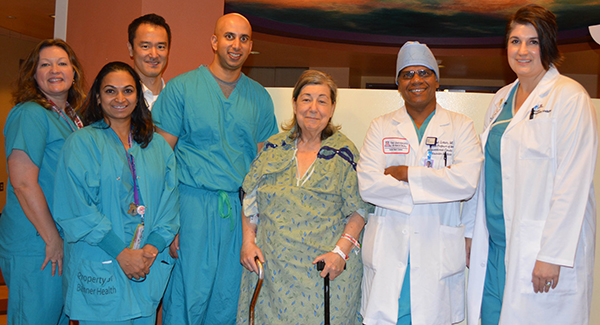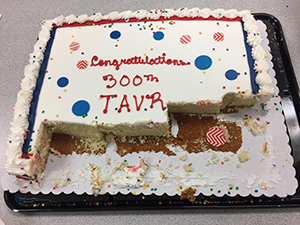 Kathleen Rothwell, 73, of Silver City, N.M., became the 300th transcatheter aortic valve replacement (TAVR) patient at at Banner – University Medical Center Tucson when she was referred to the University of Arizona cardiology team in early April to be treated for aortic stenosis—a narrowing of the valve in the large blood vessel branching off the heart—and coronary arterial disease.
Kathleen Rothwell, 73, of Silver City, N.M., became the 300th transcatheter aortic valve replacement (TAVR) patient at at Banner – University Medical Center Tucson when she was referred to the University of Arizona cardiology team in early April to be treated for aortic stenosis—a narrowing of the valve in the large blood vessel branching off the heart—and coronary arterial disease.
The UA Structural Heart Disease team at the UA Division of Cardiology, UA Sarver Heart Center and Banner – UMC Tucson includes cardiologists Kapil Lotun, MD, and Ranjith Shetty, MD; cardiothoracic surgeon Toshinobu Kazui, MD, PhD; anesthesiologist Samata Paidy, MD; Kristie Fry, ACNP-BC; Devan Lodge, RN, MSc, CCRN; Monique Crawford, RN, MSN; and Kimberly Emmons, CMA.
UA Structural Heart Disease team with their 300th patient (from left) Kristie Fry, ACNP-BC, Samata Paidy, MD, Toshinobu Kazui, MD, PhD, Ranjith Shetty, MD, Kathleen Rothwell, Kapil Lotun, MD, Devan Lodge, RN, MSc, CCRN.
“This procedure gives hope to a lot of people who are at increased risk and/or too frail for surgical valve replacement,” said Dr. Lotun, an associate professor in the UA Division of Cardiology, Structural Heart Disease Program and Vascular Medicine director at the UA Sarver Heart Center and Catheterization Laboratory director at Banner – UMC Tucson. “A lot of these patients are high risk or intermediate risk due to other co-existing medical conditions they may suffer from which may limit their ability to recover from traditional open-heart surgery. TAVR provides a minimally invasive approach for these patients.”

 He said Rothwell’s TAVR procedure was completed on the afternoon of Wednesday, April 4. They celebrated the achievement with cake and balloons that Friday.
He said Rothwell’s TAVR procedure was completed on the afternoon of Wednesday, April 4. They celebrated the achievement with cake and balloons that Friday.
A Surprise Diagnosis
After an echocardiogram a month earlier, Rothwell was surprised to find out from her cardiologist in Silver City that she suffered from stage 4 heart failure. As is typical of many women with heart disease, she cared for others in her family and hadn’t taken time to go to the doctor for herself—blaming her breathlessness on other things.
“When I lived in Miami and couldn’t breathe, I blamed it on the heat, humidity and general congestion of that big city,” Rothwell said. “When I moved to Silver City, I blamed it on the elevation. I was experiencing breathlessness for two years before I went to a doctor,” she added.
Rothwell was first evaluated for open-heart surgery involving aortic valve replacement and coronary artery bypass (CABG) procedures, but her advanced heart disease made her too frail for such an invasive procedure.
The Structural Heart Disease Team first implanted several stents to open the coronary arteries and restore blood flow to the heart muscle.
A few days later, they replaced Kathleen’s aortic valve using the TAVR method in which a catheter is percutaneously inserted through a blood vessel via a small incision in the groin. The crimped valve is guided through the artery, then positioned and opened to implant it in the aortic valve.
“I no longer feel out of breath. It’s a miracle,” she said.
Minimally Invasive Procedures
Rothwell, who had worked in libraries most of her life and eschewed Western medicine for alternative remedies, was referred by the practice of Silver City’s Norman Ratliff, MD, and Donna Bornmann, ACNP, of Gila Cardiology and the Gila Regional Medical Center.
“Usually, this is an elective outpatient procedure where patients may go home the next day, but often stay in the hospital an average of three days,” said Dr. Lotun.
“In Ms. Rothwell’s case, she was too sick for an outpatient procedure, so we admitted her after seeing her in clinic. We did an angiogram and a stent procedure. The TAVR procedure itself took about an hour—and she was home by the second day after the procedure.”
During the TAVR surgery, the team took what’s called a “minimalist approach,” where the patient is not intubated and does not go under general anesthesia, but rather is actually awake during the procedure, he added. "We were one of the first centers in Arizona to adopt this approach and perform the majority of our cases in this manner," Dr. Lotun said.
A Milestone Worth the Wait
The UA/Banner TAVR Program is an important program for the Tucson area, said Dr. Shetty, a UA assistant professor and associate director of the Structural Heart Disease and TAVR Programs.
"This program was the first of its kind in Southern Arizona," Dr. Shetty said, "and, with steady growth under Dr. Lotun's leadership over the course of more than five years, has proven its worth."
The first TAVR procedure at the hospital was performed Aug. 14, 2012.
The 300 procedures milestone, Dr. Lotun added, is a big deal because “it shows the truly multidisciplinary approach we take to patient care. Our team includes cardiologists, cardiothoracic and vascular surgeons, cardiac anesthesiologists, radiologists, and staff for the catheterization lab, operating room, radiology and echocardiography, the nursing force, the physical therapists and cardiac rehabilitation specialists. That’s a lot of people looking out for your well-being.”
Given an initial recommendation of choosing specialty care in Albuquerque or Tucson, Rothwell said, “I selected Tucson and I’m so grateful I was guided here.”
About the UA Sarver Heart Center
The University of Arizona Sarver Heart Center in Tucson, Ariz., emphasizes a highly interdisciplinary research environment fostering innovative translational or “bench-to-bedside” research. Working toward a future free of cardiovascular disease and stroke, the center’s more than 170 scientist and physician members collaborate with the goal of applying new findings from the basic sciences to the clinical arena as quickly as possible. Learn more at http://heart.arizona.edu
To stay in tune with the cardiologists at the University of Arizona College of Medicine – Tucson and Banner – UMC Tucson, you can follow our physicians and clinical staff using the following social media tags: @UofAStructuralHeart (Facebook) | @SarverHeart (Facebook) and @SarverHeart (Twitter) | @UAMedicineEdu (Facebook) and @UAMedicineEdu (Twitter) – Department of Medicine | @UACOM.Tucson (Facebook) or @UAMedTucson (Twitter) – UA College of Medicine – Tucson | @UAHealthSciences (Facebook) or @UAHealthNet (Twitter) – University of Arizona Health Sciences
—David Mogollón and Katie Maass

